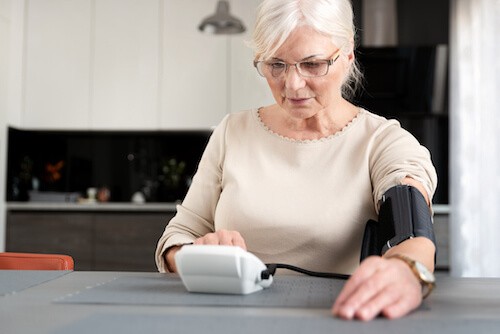
Peripheral artery disease, or PAD, is a common, progressive condition in older adults in which blood flow in the arteries of the legs becomes increasingly restricted. If left undiagnosed and untreated, PAD can lead to serious complications may range from cramping and pain in the legs when walking to non-healing wounds and even amputation. In some instances of advanced PAD, amputation of a limb may become necessary. PAD is also associated with an increased risk for life-threatening complications such as stroke and heart failure[1]. Early detection and treatment are essential in order to avoid these complications.
Who Gets PAD?
One in 20 Americans over age 50 have PAD, and for those above 80 years old, the likelihood increases to 1 in 5[1].
In approximately 90% of PAD patients, the root cause is the build-up of fatty deposits, or plaque, along the inner walls of arteries, causing a narrowing of the arteries and impairing blood flow. Though PAD can occur in any artery, it usually affects the arteries of the legs.

Having high cholesterol or high blood pressure increases your risk for PAD. Also, having diabetes increases the risk for PAD by 2-4 times[1], and smoking increases the risk by 2.5 times. Similarly, obesity and a sedentary lifestyle contribute to PAD development, and genetics also plays a role. If someone in your family has PAD, you are more likely to develop the condition.
How Is PAD Diagnosed?
PAD can be tricky to diagnose as it is largely a silent disease, with more than 50% of patients showing no symptoms at all[2]. When symptoms of PAD do occur, they most commonly show up as sensations of pain, aching, cramping, fatigue, or numbness that are brought on by walking or other physical activity and subside with rest[3].
Because PAD is usually non-symptomatic, screening tests are extremely helpful. If you are over the age of 50 and have one or more risk factors, a thorough vascular physical exam will help reveal early signs of reduced blood flow in the arteries. These examination procedures are simple, gentle, and non-invasive. They include checking blood pressure and pulses in the foot and leg, listening for the telltale sounds of turbulent blood flow, observing the color and skin temperature of the foot and leg, and observing for signs of hair loss, muscle weakness, sores, or other changes.
If a physical examination shows possible PAD, further testing via ultrasound, CT scan, or arteriogram (injection of dye into the artery) is performed to precisely determine the location and extent of the problem.
How Is PAD Treated?

Early-stage PAD can usually be managed conservatively by addressing the causative and contributing factors. This means lowering elevated cholesterol with medication and a healthy diet, preventing blood clots with low-dose aspirin or blood-thinning medication, and quitting tobacco use, if that is a factor. Your doctor may also recommend a supervised exercise walking program where you can safely improve your strength and circulation.
Advanced PAD is treated using a minimally invasive procedure called atherectomy. In this procedure, which is completed without general anesthesia, a catheter is inserted into the affected artery. An instrument at the end of the catheter carefully shaves off the inside of the plaque, opening the artery so that blood can flow through. During the procedure, the removed portions of the plaque are deposited into a holding chamber and removed along with the catheter. In some instances, an atherectomy may be combined with a balloon procedure to expand the artery. A long-term study followed patients for 24 months after the combination approach and found that the combination was significantly more effective than the balloon procedure by itself, resulting in better blood flow, less need for further interventions, and fewer adverse effects[4].

Atherectomy does not require a stay at a hospital, and healing is rapid with little downtime involved, and patients return home the same day. In a small clinical trial of 60 patients with advanced occlusion of a major artery of the leg, all participants had moderate to significant improvement immediately following the procedure[5].
Empire Vein and Vascular Specialists board-certified vascular surgeons are renowned experts in PAD treatment and have performed more atherectomy procedures than any other vascular practice in the Coachella Valley. Empire Vein and Vascular Specialists also have a state-of-the-art Outpatient Vascular Center where PAD treatments are performed.
If you are concerned about PAD and wish to be seen by one of our board-certified vascular surgeons, please call 1-888-263-7089. To learn more about Empire Vein and Vascular Specialists PAD expertise, please visit our website.

Empire Vein and Vascular Specialists is the premier vein and vascular practice in the Coachella Valley. With three convenient locations Valley-wide, our board-certified vascular surgeons provide the most advanced treatment of complex vascular disorders and arterial disease, including treatments for peripheral artery disease, abdominal aortic aneurysm, carotid artery disease, and more. We are also nationally recognized as the leader in VenaSealTM treatment, the most advanced, non-surgical treatment of varicose veins.
References
- Update on peripheral artery disease: Epidemiology and evidence-based facts. Atherosclerosis, 2018. 275: p. 379-381
https://www.ncbi.nlm.nih.gov/pubmed/29843915 - The toe-brachial index in the diagnosis of peripheral arterial disease. J Vasc Surg, 2013. 58(1): p. 231-8
https://www.ncbi.nlm.nih.gov/pubmed/23688630 - Loscalzo, MACJ, Chapter 275: Arterial Diseases of the Extremities. Harrison’s Principles of Internal Medicine, 20e.
https://accessmedicine.mhmedical.com/content.aspx?bookId=2129§ionId=192030522 - Efficacy and Safety of TurboHawk Plaque Rotation Combined With Drug-coated Balloon in Treating Diabetic Patients With Lower Extremity Arterial Disease. Clin Appl Thromb Hemost, 2020. 26:1076029620915979
https://www.ncbi.nlm.nih.gov/pubmed/32243192 - Evaluation of TurboHawk Plaque Rotation System in Treatment of Superficial Femoral Atherosclerosis. Med Sci Monit, 2018. 24: p. 9026-9031
https://www.ncbi.nlm.nih.gov/pubmed/30543205